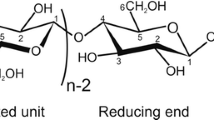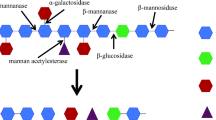Abstract
Family GH19 chitinases have been recognized as important in the plant defense against fungal pathogens. However, their substrate-recognition mechanism is still unknown. We report here the first resonance assignment of NMR spectrum of a GH19 chitinase from moss, Bryum coronatum (BcChi-A). The backbone signals were nearly completely assigned, and the secondary structure was estimated based on the chemical shift values. The addition of the chitin dimer to the enzyme solution perturbed the chemical shifts of HSQC resonances of the amino acid residues forming the putative substrate-binding cleft. Further NMR analysis of the ligand binding to BcChi-A will improve understanding of the substrate-recognition mechanism of GH-19 enzymes.



Similar content being viewed by others
Abbreviations
- GlcNAc:
-
N-acetyl-d-glucosamine
- (GlcNAc)n :
-
β-1,4-linked oligosaccharide of GlcNAc
- NMR:
-
Nuclear magnetic resonance
- HSQC:
-
Two-dimensional heteronuclear single quantum correlation
References
Arakane Y, Muthukrishnan S (2010) Insect chitinase and chitinase-like proteins. Cell Mol Life Sci 67:201–216
Bhattacharya D, Nagpure A, Gupta RK (2007) Bacterial chitinases: properties and potential. Crit Rev Biotechnol 27:21–28
Cornilescu G, Delaglio F, Bax A (1999) Protein backbone angle restraints from searching a database for chemical shift and sequence homology. J Biomol NMR 13:289–302
Delaglio F, Grzesiek S, Vuister GW, Zhu G, Pfeifer J, Bax A (1995) NMRPipe: a multidimensional spectral processing system based on UNIX pipes. J Biol NMR 6:277–293
Donnelly LE, Barnes PJ (2004) Acidic mammalian chitinase—a potential target for asthma therapy. Trends Pharmacol Sci 25:509–511
Duo-Chuan L (2006) Review of fungal chitinases. Mycopathologia 161:345–360
Goddard TD, Kneller DG, SPARKY 3, University of California, San Francisco
Hart PJ, Monzingo AF, Ready MP, Ernst SR, Robertus JD (1993) Crystal structure of an endochitinase from Hordeum vulgare L. seeds. J Mol Biol 229:189–193
Henrissat B, Bairoch A (1993) New families in the classification of glycosyl hydrolases based on amino acid sequence similarities. Biochem J 293:781–788
Hoell IA, Dalhus B, Heggset EB, Aspmo SI, Eijsink VG (2006) Crystal structure and enzymatic properties of a bacterial family 19 chitinase reveal differences from plant enzymes. FEBS J 273:4889–4900
Huet J, Rucktooa P, Clantin B, Azarkan M, Looze Y, Villeret V, Wintjens R (2008) X-ray structure of papaya chitinase reveals the substrate binding mode of glycosyl hydrolase family 19 chitinases. Biochemistry 47:8283–8291
Kasprzewska A (2003) Plant chitinases-regulation and function. Cell Mol Biol Lett 8:809–824
Monzingo AF, Marcotte EM, Hart PJ, Robertus JD (1996) Chitinases, chitosanases, and lysozymes can be divided into procaryotic and eucaryotic families sharing a conserved core. Nat Struct Biol 3:133–140
Ohnuma T, Sørlie M, Fukuda T, Kawamoto N, Taira T, Fukamizo T (2011) Chitin oligosaccharide binding to a family GH19 chitinase from the moss, Bryum coronatum. FEBS J 278:3991–4001
Pace CN, Vajdos F, Fee L, Grimsley G, Gray T (1995) How to measure and predict the molar absorption coefficient of a protein. Protein Sci 4:2411–2423
Peitsch M (1995) Protein modeling by E-mail. Bio/Technology 13:658–660
Taira T, Mahoe Y, Kawamoto N, Onaga S, Iwasaki H, Ohnuma T, Fukamizo T (2011) Cloning and characterization of a small family 19 chitinase from moss (Bryum coronatum). Glycobiology 21:644–654
Ubhayasekera W, Rawat R, Ho SW, Wiweger M, von Arnold S, Chye ML, Mowbray SL (2009) The first crystal structures of a family 19 class IV chitinase: the enzyme from Norway spruce. Plant Mol Biol 71:277–289
Wishart DS, Bigam CG, Holm A, Hodges RS, Sykes BD (1995) 1H, 13C and 15N random coil NMR chemical shifts of the common amino acids. I. Investigations of nearest-neighbor effects. J Biomol NMR 5:67–81
Author information
Authors and Affiliations
Corresponding author
Rights and permissions
About this article
Cite this article
Shinya, S., Nagata, T., Ohnuma, T. et al. Backbone chemical shifts assignments, secondary structure, and ligand binding of a family GH-19 chitinase from moss, Bryum coronatum . Biomol NMR Assign 6, 157–161 (2012). https://doi.org/10.1007/s12104-011-9346-x
Received:
Accepted:
Published:
Issue Date:
DOI: https://doi.org/10.1007/s12104-011-9346-x




